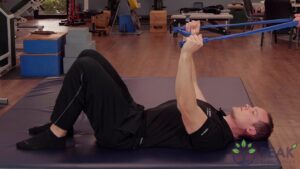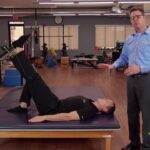Dead Bug with Band | Early Intervention Ergonomics
What is the Dead Bug with Band Exercise?
The dead bug with band exercise is beneficial for core stability and strength, as well as improving coordination and balance. The resistance band adds an extra challenge by providing tension that you must work against. It also helps engage the muscles of the upper body while performing the exercise.
To perform the dead bug with a band exercise, you will need an exercise resistance band like a therapy band. Here’s how to do it:
- Start by lying on your back on an exercise mat or the floor. Bend your knees and bring them up so that your thighs are perpendicular to the floor. Your lower legs should be parallel to the floor, with your calves parallel to the ceiling.
- Hold the exercise resistance band with both hands, and wrap it around a solid stable surface. This creates tension in the band.
- Begin the exercise by engaging the latissimus dorsi muscle by pulling the band down to where your hands and arms are perpendicular to the floor (see video above) so that you feel that your abs are nice and tight.
- Bring one knee up then the other knee up. Keep them both bent. This is the beginning position of the exercise.
- Keeping everything tight and engaged, slowly bring one heel down and touch the floor and then back up.
- Repeat the movement on the opposite heel. Do both sides for the desired amount of repetitions.
- As your muscles grow stronger, you can straighten out your leg a little more when touching the heel to the floor.
Early Intervention Benefits
The dead bug with band exercise offers numerous early intervention benefits. By incorporating this exercise into your routine, you can enhance core strength, improve stability, and promote overall body coordination and balance. Let’s delve into the specific advantages of this exercise:
- Core Strengthening: The dead bug with band targets the muscles of your core, including the abdominal muscles, lower back, and hip flexors. Strengthening these muscles can help improve posture, stabilize the spine, and enhance overall functional strength.
- Injury Prevention: A strong core plays a crucial role in injury prevention. By strengthening the muscles around your spine and pelvis, this exercise can help reduce the risk of back pain and injuries. It also improves the stability of your hips, which can contribute to better movement mechanics and lower the likelihood of hip-related issues.
- Improved Stability and Balance: The dead bug exercise challenges your core stability and requires coordination between the upper and lower body. By practicing this exercise regularly, you can enhance your body’s ability to stabilize and maintain balance, reducing the risk of falls or injuries during your daily work activities.
- Enhanced Performance: The dead bug with band exercise is beneficial for athletes and fitness enthusiasts. It helps improve overall body control, stability, and coordination, which can translate into better performance in various work activities.
- Increased Body Awareness: Performing the dead bug exercise requires conscious engagement of specific muscle groups. This increased body awareness can carry over into your daily life, helping you maintain proper posture, move efficiently, and make conscious choices about body alignment and positioning during other exercises or work activities.
Things to Remember
As with any exercise, it’s essential to maintain proper form and start with a resistance level that is appropriate for your fitness level. If you’re new to this exercise, you may want to begin without the resistance band and gradually incorporate it as you become more comfortable and stronger. Be sure to maintain proper form throughout the entire exercise. As with any exercise, consult with a qualified fitness professional if you have any underlying health conditions or concerns.
These early intervention exercises are to improve overall health & fitness as well as help reduce work-related injuries. If you have an injury or illness, consult with a health care professional before attempting.
Contact us for more information on how we can help your employees stay safe.
Resources
More Tools & Resources from Peak Ergonomics
Contact Us About Reducing Workplace Injuries
Healthy Employees are the Bottom Line! – Learn More!


